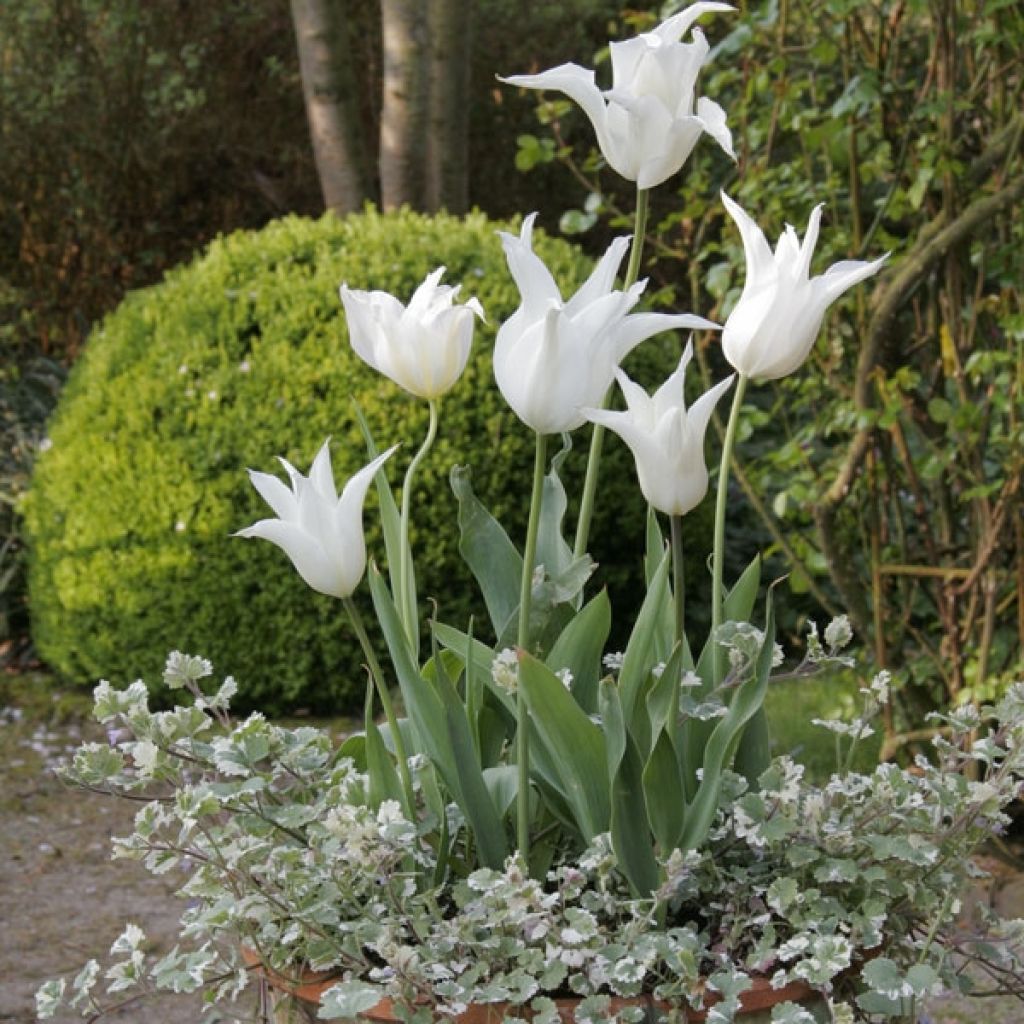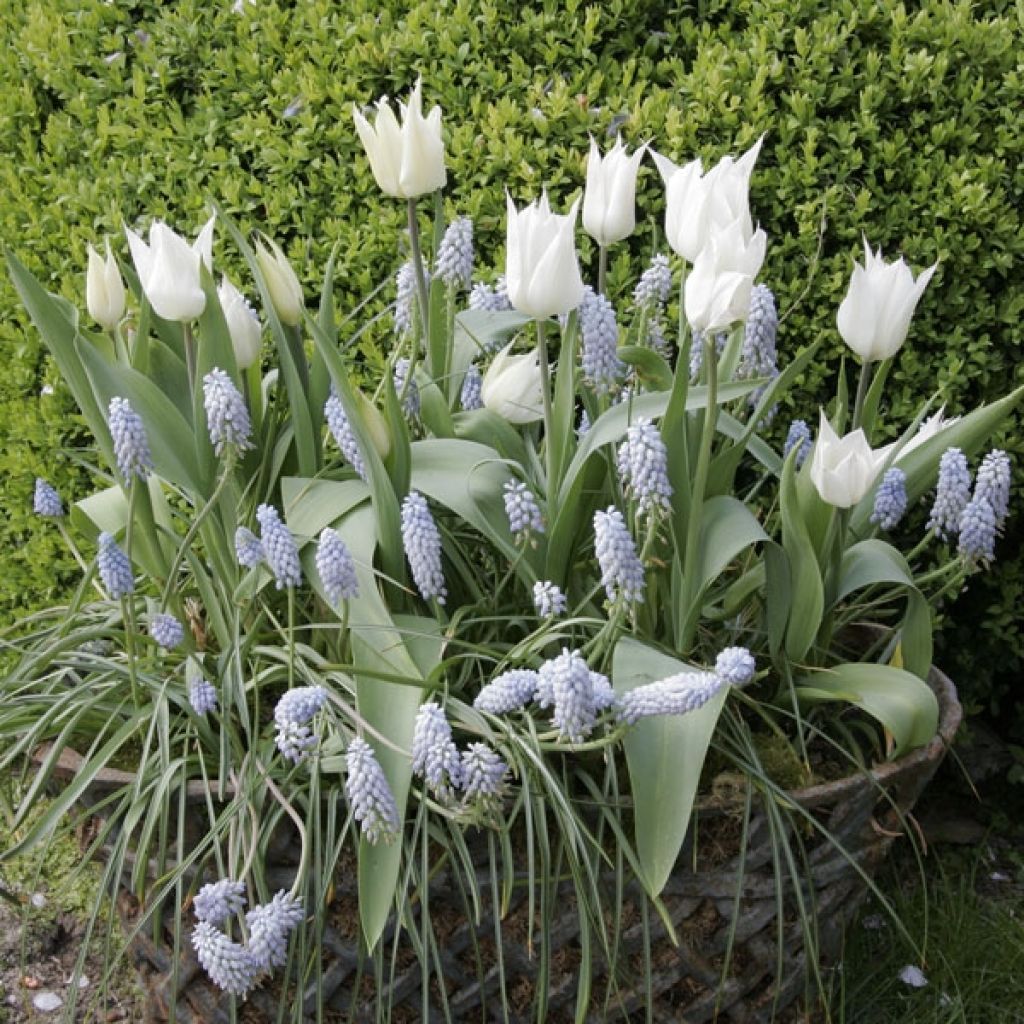

Tulipa Sapporo - Lily flowering Tulip


Tulipa Sapporo - Lily flowering Tulip


Tulipa Sapporo - Lily flowering Tulip
Tulipa Sapporo - Lily flowering Tulip
Tulipa Sapporo
Tulip
Beautiful bulbs and very beautiful flowers but I wanted white ones and they are orange, it doesn't go with the rest of the flowerbed! A little disappointed.
Caduros, 09/04/2024
This plant carries a 6 months recovery warranty
More information
We guarantee the quality of our plants for a full growing cycle, and will replace at our expense any plant that fails to recover under normal climatic and planting conditions.
From €5.90 for pickup delivery and €6.90 for home delivery
Express home delivery from €8.90.

Does this plant fit my garden?
Set up your Plantfit profile →
Description
The 'Sapporo' Tulip offers in April-May its long, elegant water lily flower, with undeniable elegance in bouquets or in flower beds. When it blooms, this flower is a buttery yellow, then it quickly fades to white-cream and opens up into an ivory-white star. Perched on short stems, the 'Sapporo' flowers blend into the colourful mosaic formed by the other water lily tulips, as they all bloom at the same time, for several weeks. 'Sapporo' lives for many years in the garden, and reliably blooms every year.
The 'Sapporo' water lily tulip belongs to the lily family. Introduced in 1992, it is classified in division 6 of horticultural tulips. The main characteristics of this category are as follows: they have single flowers and bloom in the second half of spring, the cups are narrow, the pointed tepals are recurved at opening and open up into 8 cm (3in) wide stars. During the day, these flowers become spider-like and widely open. They were created in the early 20th century. This 'Sapporo' variety will not exceed 40 cm (16in) in height when in bloom. The flowering, like an explosion of white stars, takes place in late April or early May. The foliage is thinner than that of other tulips. Each solitary flower is supported by a delicate-looking stem, but very resistant to bad weather.
A rediscovery, water lily tulips have become rare in our gardens. The 'Sapporo' tulip finds its place in large flower beds, especially in a white garden. It is an excellent alternative to the 'White Triumphator' variety, as its shorter stem harmonises in height with the other fleur-de-lis tulips. Its neutral and pure colour allows for associations with tulips in a wide range of shades. This also maximises the flowering duration of the flower beds. Combine it with Corsican hellebores and euphorbias, and you will create surprising scenes. It can also be planted in borders, rock gardens, flower beds, as well as in pots and containers. It pairs perfectly with tall perennials and is ideal for creating elegant bouquets. In a vase, use very little water. Furthermore, if your tulips open too quickly, you can add two to three ice cubes to the vase each day. Many varieties of water lily tulips are grown for forcing and produce cut flowers for a large part of the year.
Our advice: Pair it with grape hyacinths as shown in the photograph.
Report an error about the product description
Plant habit
Flowering
Foliage
Botanical data
Tulipa
Sapporo
Liliaceae
Tulip
Cultivar or hybrid
Planting and care
Place the 'Sapporo' tulips in a sunny or partially shaded location from September to December for spring flowering. Plant the bulbs in a light, fertile, and well-drained soil, and loosen it to a depth of 15 cm (6in). Space the bulbs 10 cm (4in) apart without touching each other to create a mass effect; cut the flower stems after flowering. Allow the leaves to completely dry before cutting them. Also, make a weekly application of balanced liquid fertiliser during the first month.
Planting period
Intended location
Care
-
, onOrder confirmed
Reply from on Promesse de fleurs
Haven't found what you were looking for?
Hardiness is the lowest winter temperature a plant can endure without suffering serious damage or even dying. However, hardiness is affected by location (a sheltered area, such as a patio), protection (winter cover) and soil type (hardiness is improved by well-drained soil).

Photo Sharing Terms & Conditions
In order to encourage gardeners to interact and share their experiences, Promesse de fleurs offers various media enabling content to be uploaded onto its Site - in particular via the ‘Photo sharing’ module.
The User agrees to refrain from:
- Posting any content that is illegal, prejudicial, insulting, racist, inciteful to hatred, revisionist, contrary to public decency, that infringes on privacy or on the privacy rights of third parties, in particular the publicity rights of persons and goods, intellectual property rights, or the right to privacy.
- Submitting content on behalf of a third party;
- Impersonate the identity of a third party and/or publish any personal information about a third party;
In general, the User undertakes to refrain from any unethical behaviour.
All Content (in particular text, comments, files, images, photos, videos, creative works, etc.), which may be subject to property or intellectual property rights, image or other private rights, shall remain the property of the User, subject to the limited rights granted by the terms of the licence granted by Promesse de fleurs as stated below. Users are at liberty to publish or not to publish such Content on the Site, notably via the ‘Photo Sharing’ facility, and accept that this Content shall be made public and freely accessible, notably on the Internet.
Users further acknowledge, undertake to have ,and guarantee that they hold all necessary rights and permissions to publish such material on the Site, in particular with regard to the legislation in force pertaining to any privacy, property, intellectual property, image, or contractual rights, or rights of any other nature. By publishing such Content on the Site, Users acknowledge accepting full liability as publishers of the Content within the meaning of the law, and grant Promesse de fleurs, free of charge, an inclusive, worldwide licence for the said Content for the entire duration of its publication, including all reproduction, representation, up/downloading, displaying, performing, transmission, and storage rights.
Users also grant permission for their name to be linked to the Content and accept that this link may not always be made available.
By engaging in posting material, Users consent to their Content becoming automatically accessible on the Internet, in particular on other sites and/or blogs and/or web pages of the Promesse de fleurs site, including in particular social pages and the Promesse de fleurs catalogue.
Users may secure the removal of entrusted content free of charge by issuing a simple request via our contact form.
The flowering period indicated on our website applies to countries and regions located in USDA zone 8 (France, the United Kingdom, Ireland, the Netherlands, etc.)
It will vary according to where you live:
- In zones 9 to 10 (Italy, Spain, Greece, etc.), flowering will occur about 2 to 4 weeks earlier.
- In zones 6 to 7 (Germany, Poland, Slovenia, and lower mountainous regions), flowering will be delayed by 2 to 3 weeks.
- In zone 5 (Central Europe, Scandinavia), blooming will be delayed by 3 to 5 weeks.
In temperate climates, pruning of spring-flowering shrubs (forsythia, spireas, etc.) should be done just after flowering.
Pruning of summer-flowering shrubs (Indian Lilac, Perovskia, etc.) can be done in winter or spring.
In cold regions as well as with frost-sensitive plants, avoid pruning too early when severe frosts may still occur.
The planting period indicated on our website applies to countries and regions located in USDA zone 8 (France, United Kingdom, Ireland, Netherlands).
It will vary according to where you live:
- In Mediterranean zones (Marseille, Madrid, Milan, etc.), autumn and winter are the best planting periods.
- In continental zones (Strasbourg, Munich, Vienna, etc.), delay planting by 2 to 3 weeks in spring and bring it forward by 2 to 4 weeks in autumn.
- In mountainous regions (the Alps, Pyrenees, Carpathians, etc.), it is best to plant in late spring (May-June) or late summer (August-September).
The harvesting period indicated on our website applies to countries and regions in USDA zone 8 (France, England, Ireland, the Netherlands).
In colder areas (Scandinavia, Poland, Austria...) fruit and vegetable harvests are likely to be delayed by 3-4 weeks.
In warmer areas (Italy, Spain, Greece, etc.), harvesting will probably take place earlier, depending on weather conditions.
The sowing periods indicated on our website apply to countries and regions within USDA Zone 8 (France, UK, Ireland, Netherlands).
In colder areas (Scandinavia, Poland, Austria...), delay any outdoor sowing by 3-4 weeks, or sow under glass.
In warmer climes (Italy, Spain, Greece, etc.), bring outdoor sowing forward by a few weeks.


































